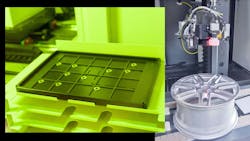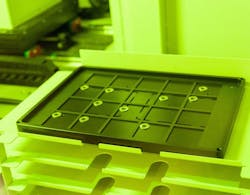The unique characteristics of lasers, such as their focusability and ability to work on a variety of materials, make them well suited for precision manufacturing. And they can be used with a wide variety of processes, including cutting, welding, drilling, marking, engraving and surface treating materials ranging from metals to plastics, ceramics, glasses and organics.
Combining industrial lasers with automation lets companies efficiently process complex part geometries and materials that would not have been considered 5 to 10 years ago.
Recent examples include large-scale texturing of polymer and metal parts with freeform surfaces such as automobile dashboards, bumpers, and other parts three feet or more in size. Lasers are also being used on small, mechanically fragile parts such as the micro wires and coils in medical devices that embolize small vessels in the brain of stroke victims who have experienced aneurysms. These devices are made from delicately wire-wound materials such as platinum and Nitinol and are usually 50 microns or less in diameter.
Getting the Right Laser
Selecting the proper laser source—semi-conductor, gas, fiber, or solid state—is the first step in automating laser production for complex parts. It is the heart of the system and is selected based on its ability to give the desired processing effect when matched with the optical absorption and thermal properties of the part’s material. The laser must also deliver the desired levels of performance, quality, cost and throughput.
Matching the laser’s capabilities with application variables must be done to identify the laser source that best balances performance, quality, throughput and cost, and this is even more important with unforgiving and delicate parts. This is best done by application labs equipped with the identical laser source that will be used. It is important the lab uses the exact laser early to avoid repeating costly and lengthy development work later.
Successfully adding lasers to the automation mix is a function of the automation hardware, vision subsystems, optics, laser beam delivery, software, databases and laser sources used in the system.
Adding the laser source into the system for processing complex parts is also a specialized task that requires significant technological expertise. This is especially true when making parts for automotive and healthcare products when relevant safety, mechanical and electrical standards, as well as regulations, must be met.
Options Make all the Difference
Laser structuring, texturing, marking, and engraving are typically handled by fiber lasers delivering short, sharp pulses focusable to spot sizes of 10 to 40 µm and with durations measured in nano to femto seconds (10 × 10−9 to 150 × 10−15 sec.). This means the laser delivers short intervals of high levels of power. These lasers are connected to galvanometer scanning heads (galvos), which steer the laser beam over processing areas of 110 × 110 mm using standard optics.
Although this is relatively simple for flat 2D parts, it becomes cumbersome—often impossible—on larger 3D components such as complicated automotive alloy wheels that must be marked with tiny features and intricate details over their entire surface. That’s because it requires several step-index moves and alignments to process the surface at the required resolution.
Using the conventional method just described often leaves some segments of the pattern disconnected rather than seamless. This can be fixed by using a laser system that can wrap 2D CAD designs over 3D surfaces as large as 1,250 mm without any indexing movements of the workpiece or laser head. The process is carried out in one continuous, uninterrupted operation in which a small laser spot is used over the entire processing area. The small spot maintains the same level of resolution over the area and simplifies the production of small features. These large field removal systems, as they are called, reduce processing steps, and make it easy to process complex parts.
Final Steps
Now that lasers can machine large 3D parts in a continuous uninterrupted process, the next questions may well be:
- How can they locate exactly where on this complex part the features are going to be processed given the part tolerances?
- Is the part in the correct orientation for processing, and how can this be verified?
All of these questions can be resolved by using a laser-vision subsystem and automated part handling. This generally requires a high-definition camera looking down the same line of sight and optics as the laser beam or parallel to it. It also requires image-processing software that can identify a reference position on the part, such as a fiducial mark (a feature such as a hole of a particular shape) or a color contrast in certain areas. With this information and the part’s pre-programmed CAD data, the vision subsystem can determine offsets to correctly orientate parts and the laser head before processing by using either a laser galvo head, robotics, a cartesian-axis subsystem, or a combination of these.
The vision subsystem will report offsets for processing areas of interest and height and depth information about the parts. Lighting and contrast are critical to the vision subsystem’s performance on complex parts. Another set of critical factors are the positioning subsystem’s accuracy and repeatability; they ensure that laser processing starts at the right position.
For processing small parts, 100 µm or smaller, these laser systems must be more complex
An example of such a task would be to locate a 50 to 100 µm diameter platinum or Nitinol wire and weld it to another wire. Small parts push the vision subsystem’s camera in terms of resolution. The mechanical axes and part-handling devices are also pushed, but in terms of their repeatability and ability to stop where required. The laser is also going to be working near the limits of its power control to ensure a repeatable and uniform process.
It is crucial that designers begin the task of combining laser processing and automated part handling by clearly understanding the application’s requirements. Even small changes in the application’s materials, part geometries or quality constraints have a major influence on machine design, and it better to fix the requirements at the outset to get the best machine.
Jonathan Magee is managing director at ACSYS Lasertechnik UK Ltd, Coventry, U.K.



